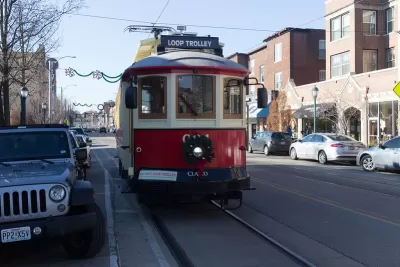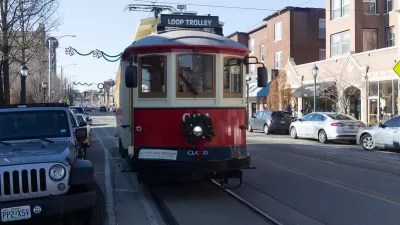St. Louis faces losing federal funds if the Loop Trolley remains defunct. But is the 2.2-mile line worth it?

According to Tony Nipert, "the Federal Transit Administration (FTA) warned St. Louis that it needed to forge a plan to jumpstart the Loop Trolley by June 1st or pay back the federal grant money allocated to the project." The 2.2-mile trolley line, which opened in November 2018, garnered criticism during its tenure and was shut down in December 2019.
As Nipert writes, the city has three options. One is to remove the trolley line altogether, an option supported by many who see it as a sunk cost but that others argue would harm future potential funding. The second choice would be to expand the trolley's reach to serve more tourist locations in Forest Park. While the line may never become a robust part of the city's transit network, it could at least become a more useful and well-used tourism asset.
The third option, according to Nipert, is to operate the trolley long enough to receive the federal grant funding, then reassess. This approach, supported by St. Louis mayor Tishaura Jones, could afford the trolley "a chance to build a reputation based on its service and utility to patrons" and buy time for the line to potentially become financially self-sustaining.
While the trolley could still fail to meet residents' needs, Nipert argues that reopening it for the duration of the grant could give it a chance to thrive.
FULL STORY: WHAT TO DO WITH THE LOOP TROLLEY?

Study: Maui’s Plan to Convert Vacation Rentals to Long-Term Housing Could Cause Nearly $1 Billion Economic Loss
The plan would reduce visitor accommodation by 25,% resulting in 1,900 jobs lost.

North Texas Transit Leaders Tout Benefits of TOD for Growing Region
At a summit focused on transit-oriented development, policymakers discussed how North Texas’ expanded light rail system can serve as a tool for economic growth.

Why Should We Subsidize Public Transportation?
Many public transit agencies face financial stress due to rising costs, declining fare revenue, and declining subsidies. Transit advocates must provide a strong business case for increasing public transit funding.

How to Make US Trains Faster
Changes to boarding platforms and a switch to electric trains could improve U.S. passenger rail service without the added cost of high-speed rail.

Columbia’s Revitalized ‘Loop’ Is a Hub for Local Entrepreneurs
A focus on small businesses is helping a commercial corridor in Columbia, Missouri thrive.

Invasive Insect Threatens Minnesota’s Ash Forests
The Emerald Ash Borer is a rapidly spreading invasive pest threatening Minnesota’s ash trees, and homeowners are encouraged to plant diverse replacement species, avoid moving ash firewood, and monitor for signs of infestation.
Urban Design for Planners 1: Software Tools
This six-course series explores essential urban design concepts using open source software and equips planners with the tools they need to participate fully in the urban design process.
Planning for Universal Design
Learn the tools for implementing Universal Design in planning regulations.
City of Santa Clarita
Ascent Environmental
Institute for Housing and Urban Development Studies (IHS)
City of Grandview
Harvard GSD Executive Education
Toledo-Lucas County Plan Commissions
Salt Lake City
NYU Wagner Graduate School of Public Service





























